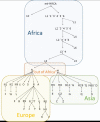Complex spatio-temporal distribution and genomic ancestry of mitochondrial DNA haplogroups in 24,216 Danes
- PMID: 30543675
- PMCID: PMC6292624
- DOI: 10.1371/journal.pone.0208829
Complex spatio-temporal distribution and genomic ancestry of mitochondrial DNA haplogroups in 24,216 Danes
Abstract
Mitochondrial DNA (mtDNA) haplogroups (hgs) are evolutionarily conserved sets of mtDNA SNP-haplotypes with characteristic geographical distribution. Associations of hgs with disease and physiological characteristics have been reported, but have frequently not been reproducible. Using 418 mtDNA SNPs on the PsychChip (Illumina), we assessed the spatio-temporal distribution of mtDNA hgs in Denmark from DNA isolated from 24,642 geographically un-biased dried blood spots (DBS), collected from 1981 to 2005 through the Danish National Neonatal Screening program. ADMIXTURE was used to establish the genomic ancestry of all samples using a reference of 100K+ autosomal SNPs in 2,248 individuals from nine populations. Median-joining analysis determined that the hgs were highly variable, despite being typically Northern European in origin, suggesting multiple founder events. Furthermore, considerable heterogeneity and variation in nuclear genomic ancestry was observed. Thus, individuals with hg H exhibited 95%, and U hgs 38.2% - 92.5%, Danish ancestry. Significant clines between geographical regions and rural and metropolitan populations were found. Over 25 years, macro-hg L increased from 0.2% to 1.2% (p = 1.1*E-10), and M from 1% to 2.4% (p = 3.7*E-8). Hg U increased among the R macro-hg from 14.1% to 16.5% (p = 1.9*E-3). Genomic ancestry, geographical skewedness, and sub-hg distribution suggested that the L, M and U increases are due to immigration. The complex spatio-temporal dynamics and genomic ancestry of mtDNA in the Danish population reflect repeated migratory events and, in later years, net immigration. Such complexity may explain the often contradictory and population-specific reports of mito-genomic association with disease.
Conflict of interest statement
The authors have declared that no competing interests exist.
Figures







References
-
- Papa S, Martino PL, Capitanio G, Gaballo A, De Rasmo D, Signorile A, et al. The oxidative phosphorylation system in mammalian mitochondria. Adv Exp Med Biol. 2012;942:3–37. 10.1007/978-94-007-2869-1_1 . - DOI - PubMed
-
- Antico Arciuch VG, Elguero ME, Poderoso JJ, Carreras MC. Mitochondrial regulation of cell cycle and proliferation. Antioxid Redox Signal. 2012;16(10):1150–80. 10.1089/ars.2011.4085 ; PubMed Central PMCID: PMCPMC3315176. - DOI - PMC - PubMed
-
- Carafoli E. The fateful encounter of mitochondria with calcium: how did it happen? Biochim Biophys Acta. 2010;1797(6–7):595–606. 10.1016/j.bbabio.2010.03.024 . - DOI - PubMed
-
- Zhang F, Zhang L, Qi Y, Xu H. Mitochondrial cAMP signaling. Cell Mol Life Sci. 2016;73(24):4577–90. 10.1007/s00018-016-2282-2 ; PubMed Central PMCID: PMCPMC5097110. - DOI - PMC - PubMed
-
- Chinnery PF, Hudson G. Mitochondrial genetics. Br Med Bull. 2013;106:135–59. 10.1093/bmb/ldt017 ; PubMed Central PMCID: PMCPMC3675899. - DOI - PMC - PubMed
Publication types
MeSH terms
Substances
LinkOut - more resources
Full Text Sources

